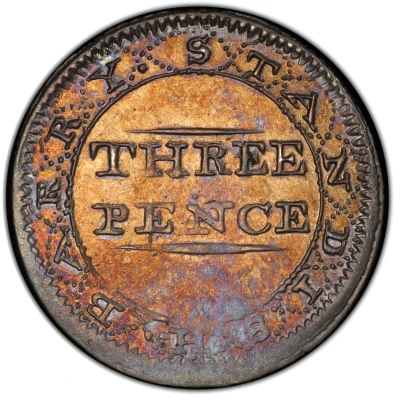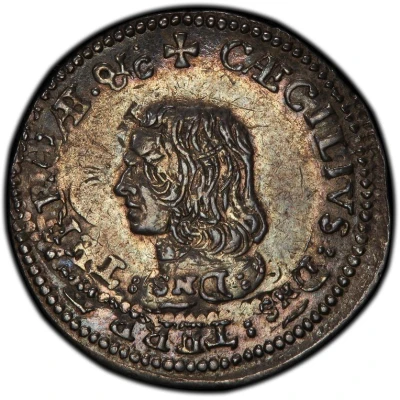


© PCGS
3 Pence - Standish Barry
1790 year| Silver | - | - |
| Issuer | Maryland (United States (pre-federal and private/territorial)) |
|---|---|
| Issuing entity | Standish Barry of Baltimore |
| Period | Federal republic (1789-date) |
| Type | Token |
| Year | 1790 |
| Value | 3 Pence (1⁄80) |
| Currency | Pound |
| Composition | Silver |
| Shape | Round |
| Technique | Milled |
| Orientation | Medal alignment ↑↑ |
| Demonetized | Yes |
| Updated | 2024-10-09 |
| Numista | N#85238 |
|---|---|
| Rarity index | 95% |
Reverse
Denomination surrounded by legend,
letters separated by dotted x's
Script: Latin
Lettering:
STANDISH • BARRY .
_____
THREE
PENCE
_____
Engraver: Standish Barry
Edge
Reeded
Comment
A small number of threepence were struck by Standish Barry, a silversmith in Baltimore, Maryland. They feature a bust, facing left, surrounded by the legend: JULY • 4 • 90 • BALTIMORE • TOWN. The reverse shows the denomination with Barry’s full name along the perimeter.For many years numismatists have speculated that the enigmatic bust on the obverse was a crude rendition of George Washington or perhaps a self-portrait of Barry. Recent research (Max B. Spiegel, “C4 Newsletter,” Spring 2009), however, uncovered contemporary sources that identify the portrait as that of James Calhoun, the first mayor of Baltimore.
The exactness of the date on the Standish Barry threepence – July 4, 1790 – has also been the subject of much speculation. It could refer to a Fourth of July celebration in the city, although no major celebration is known to have occurred in 1790. One did happen in 1809 and it was reported that the city’s silversmiths marched “under the direction of Standish Barry.” Will Nipper speculates that the “90” in the date could be a transposition of “09,” but it is unlikely that the Standish Barry threepence was issued as late as 1809.
Only around 20 Standish Barry threepence are known to have survived and most are in circulated grades. Some specimens have prominent die cracks and the piece in the collection of Colonial Williamsburg was struck from nearly shattered dies. It is likely that the dies used to strike the Standish Barry threepence failed quickly, with the result being a very limited mintage.
https://www.ngccoin.com/coin-explorer/early-american-post-declaration-pscid-122/1790-baltimore-standish-barry-3p-ms-coinid-108333
Standish Barry, Baltimore, Maryland
Standish Barry, of Baltimore, circulated a silver threepence in 1790. He was a watch and clockmaker, an engraver, and, later, a silversmith. The tokens are believed to have been an advertising venture at a time when small change was scarce. The precise date on this piece may indicate that Barry intended to commemorate Independence Day, but there are no records to prove this. The head on the obverse is probably that of James Calhoun, who was active in Baltimore politics in the 1790s. The legend BALTIMORE TOWN JULY 4, 90, appears in the border. An enigmatic gold doubloon is also attributed to Barry. https://whitman.com/RedBook/Coins/Detail/Post-Colonial-Issues+Private-Tokens-after-Confederation+Standish-Barry-Baltimore-Maryland
Interesting fact
The A Token 3 Pence - Standish Barry 1790 from Maryland (United States (pre-federal and private/territorial)) made of Silver is a rare and valuable coin. One interesting fact about this coin is that it was issued during a time when the United States was still a group of individual colonies, before the establishment of a federal government. The coin was minted by a private entity, rather than a government mint, and its value was not recognized by the British government, which had its own currency. This coin is a unique piece of American numismatic history and a testament to the early entrepreneurial spirit of the United States.



